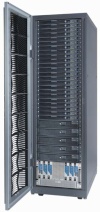Help:CSDMS HPCC
The CSDMS High Performance Computing Cluster
Hardware
Our CSDMS HPCC System is an SGI Altix XE 1300 with integrated 512 x 3.0GHz/12M/1600MHz/80W E5472 processors, using non-blocking Infiniband Interconnect with 1.152TB of memory, with one head node, 28 compute nodes, 4 compute nodes with heavy memory, associated infrastructure, 72TB/7200RPM/SATA Raid storage, web server 4 x 2.33GHz/8GB RAM E5420 processor. The CSDMS-HPCC (≈ 6Tflops) is configured with two HPC approaches: 1) massive shared memory among fewer processors, and 2) the more typical parallel configuration each running Linux Red Hat with Fortran, C and C++ compilers. This system offers to potential CSDMS researchers a state of the art HPC, once their code can be scaled up to take advantage of the capaboilities of these systems.
The CSDMS system will be tied in to the larger, overarching CU-wide Front Range Computing Consortium. This supercomputer will consist of 10 Sun Blade 6048 Modular System racks, nine deployed to form a tightly integrated computational plant, and the remaining rack to serve as a GPU-based accelerated computing system. Each computational rack is composed of four integrated Sun Blade 6000 series chassis units, containing 12 blades connected by an internal quad-data-rate InfiniBand fabric; a 24-port Network Expansion Module (NEM) provides external connectivity. Each blade is composed of two dual-socket boards with each socket containing a quad-core Intel Nehalem-EP processor clocked at an expected frequency of ≈ 3.3 GHz. Each dual-socket board has eight 2 GB DDR-3 DIMMS for a total of 16 GB of RAM (2 GB per core). Each rack contains 192 processors (768 cores), for a total of 7680 cores (including the accelerated computing rack), with a peak performance exceeding 10 Teraflops/s for aggregate system peak performance of 101.4 Teraflop/s. The storage solution will consist of a high-performance Lustre file system built on 12 to 16 Sun Thumper- 2 storage server chassis. Each of the Thumper-2 units has 48 internal disks, an 8x PCI-Express IB Host Bus Adapter (HBA), and utilizes the Sun ZFS block allocation layer to provide in excess of 800 Megabytes per second per Thumper. Using 1 Terabyte disks, the total raw capacity is between 576 and 768 Terabytes. The remaining computational rack provides the accelerated computing component using NVIDIA Tesla 870 GPU technology. The Tesla 870 GPU system is a 1U chassis containing four 128-simultaneous thread GPUs and 6 Gigabytes of RAM accessible at 76.8 Gigabytes per second. The entire system will utilize a standard Linux-based software stack, vendor-supplied IB-based MPI, and the Coordinated TerraGrid Software and Services. In addition, the Grid environment will provide access to NCAR’s mass storage system. 4.10
Software
CSDMS Web server node: (SSL certified)
- Mediawiki 1.12.3 (this is not the latest version)
- Apache
- PHP version 5.2.x or later
- With Perl Compatible regular expressions
- With Standard PHP Library
- ViewVC
- Subversion
- VersionControl_SVN 0.3.1 or newer (with Dependencies:)
- PEAR Package: PEAR 1.4.0b1 or newer
- PEAR Package: PEAR 1.3.1 or newer
- PEAR Package: XML_Parser 1.0.1 or newer
- ArcGIS license server software
- ImageMagick
- Trac
Database node:
- MySQL 5.0.x
Compute Nodes:
- Free stuff:
- Python Imaging Library (PIL)
- Udunits
- netcdf
- openmotif
- Eclipse
- Subclipse
- Pgplot
- HDF5
- Matlab
- Eucalyptus
- Languages:
- Python 2.6, 3000 (along with numpy and scipy where possible)
- Java 1.6
- GNU compilers > 4.0 (gcc, g++, gfortran)
Access
SSH Tunneling X Windows for Mac OSX
Mac OSX comes with X11. If you're using an older version of OSX, download X11 from the apple site. Open X11, select Applications and then Terminal. In the terminal type:
ssh -Y beach.colorado.edu -l <your_username>
Type <password> and that's it. Now you can test the Tunneling by for example typing <matlab>.
SSH Tunneling X Windows for Windows
Install Xming on your windows machine. Needs more info

